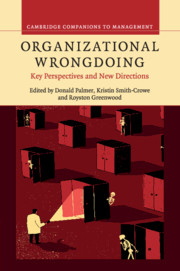Book contents
- Frontmatter
- Contents
- List of figures
- List of tables
- List of contributors
- Foreword
- 1 The imbalances and limitations of theory and research on organizational wrongdoing
- 2 On taking the theoretical substance of outcomes seriously: a meta-conversation
- 3 Wrong paths to right: defining morality with or without a clear red line
- 4 From market enablers to market participants: redefining organizational and political-legal arrangements and opportunities for financial wrongdoing,1930s–2000
- 5 Wrongdoing and market development: an examination of the distinct roles of trust and distrust
- 6 Bad apples, bad barrels and bad cellars: a “boundaries” perspective on professional misconduct
- 7 S/he blinded me with science: the sociology of scientific misconduct
- 8 Social networks and organizational wrongdoing in context
- 9 Falling stars: celebrity, infamy, and the fall from (and return to) grace
- 10 Compensation and employee misconduct: the inseparability of productive and counterproductive behavior in firms
- 11 Beware of organizational saints: how a moral self-concept may foster immoral behavior
- 12 “Is it me? Or is it me?” The role of coactivated multiple identities and identifications in promoting or discouraging workplace crimes
- 13 Consequences of organizational misconduct: too much and too little punishment
- 14 Who bears the brunt? A review and research agenda for the consequences of organizational wrongdoing for individuals
- 15 Organizational wrongdoing and media bias
- 16 Ethical learning: releasing the moral unicorn
- Index
- References
9 - Falling stars: celebrity, infamy, and the fall from (and return to) grace
Published online by Cambridge University Press: 05 July 2016
- Frontmatter
- Contents
- List of figures
- List of tables
- List of contributors
- Foreword
- 1 The imbalances and limitations of theory and research on organizational wrongdoing
- 2 On taking the theoretical substance of outcomes seriously: a meta-conversation
- 3 Wrong paths to right: defining morality with or without a clear red line
- 4 From market enablers to market participants: redefining organizational and political-legal arrangements and opportunities for financial wrongdoing,1930s–2000
- 5 Wrongdoing and market development: an examination of the distinct roles of trust and distrust
- 6 Bad apples, bad barrels and bad cellars: a “boundaries” perspective on professional misconduct
- 7 S/he blinded me with science: the sociology of scientific misconduct
- 8 Social networks and organizational wrongdoing in context
- 9 Falling stars: celebrity, infamy, and the fall from (and return to) grace
- 10 Compensation and employee misconduct: the inseparability of productive and counterproductive behavior in firms
- 11 Beware of organizational saints: how a moral self-concept may foster immoral behavior
- 12 “Is it me? Or is it me?” The role of coactivated multiple identities and identifications in promoting or discouraging workplace crimes
- 13 Consequences of organizational misconduct: too much and too little punishment
- 14 Who bears the brunt? A review and research agenda for the consequences of organizational wrongdoing for individuals
- 15 Organizational wrongdoing and media bias
- 16 Ethical learning: releasing the moral unicorn
- Index
- References
Summary
Celebrity firms are firms that attract a high level of public attention and generate positive affective responses from stakeholder audiences (Rindova, Pollock, and Hayward 2006). Recent research has explored how and why firms become celebrities (Rindova et al. 2006; Zavyalova and Pfarrer 2015) and how celebrity creates value for firms (Pfarrer, Pollock, and Rindova 2010). Celebrity firms are more likely to have unexpectedly high performance – and gain additional benefits when they do so – while suffering fewer penalties when their performance is lower than expected (Pfarrer et al. 2010).
Rindova and colleagues have also argued that firms can engender “infamy,” which results from generating a high level of public attention and negative affective responses from stakeholder audiences. Central to both celebrity and infamy is that firms must engage in “deviant” or non-conforming behaviors. When viewed positively, these behaviors create a “rebel” celebrity persona attractive to at least some stakeholders; however, if the non-conforming behaviors are viewed negatively they can lead to an “outlaw” persona that at a minimum results in a loss of celebrity and possibly increases infamy.
Although researchers have begun to explore the causes and consequences of firm celebrity, little research (for a recent exception, see Zavyalova and Pfarrer [2015]) has considered how firms become infamous. Building on Rindova and colleagues (2006), Zavyalova and Pfarrer (2015) argued that celebrity occurs through audience members’ identification with a firm's values and beliefs as presented in media-created narratives, and that infamy results from dis-identification with the organization's values and beliefs. Because firms face a plethora of stakeholder audiences with differing priorities and values, they further argued that the same firm can possess both celebrity and infamy simultaneously, as the same set of organizational values and beliefs can be the cause for identification with the firm by one stakeholder audience and dis-identification by another. Consequently, firms can lose celebrity in their quest to maintain it by eventually engaging in behaviors or revealing information that is inconsistent with audience members’ bases for identification.
Fundamental to the process of becoming infamous is the belief by a stakeholder group or groups that the firm is engaging in deviant behaviors that they consider wrongdoing.
- Type
- Chapter
- Information
- Organizational WrongdoingKey Perspectives and New Directions, pp. 235 - 269Publisher: Cambridge University PressPrint publication year: 2016
References
- 6
- Cited by



